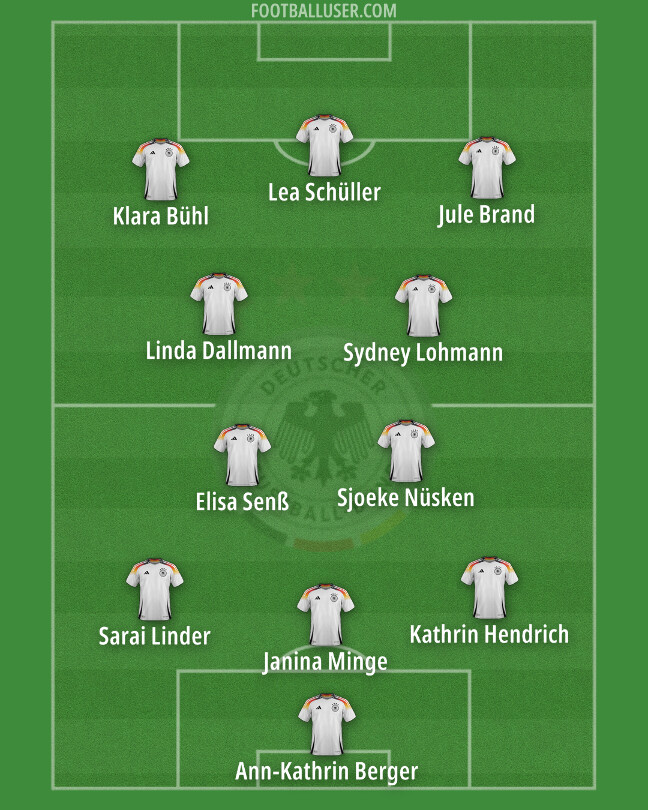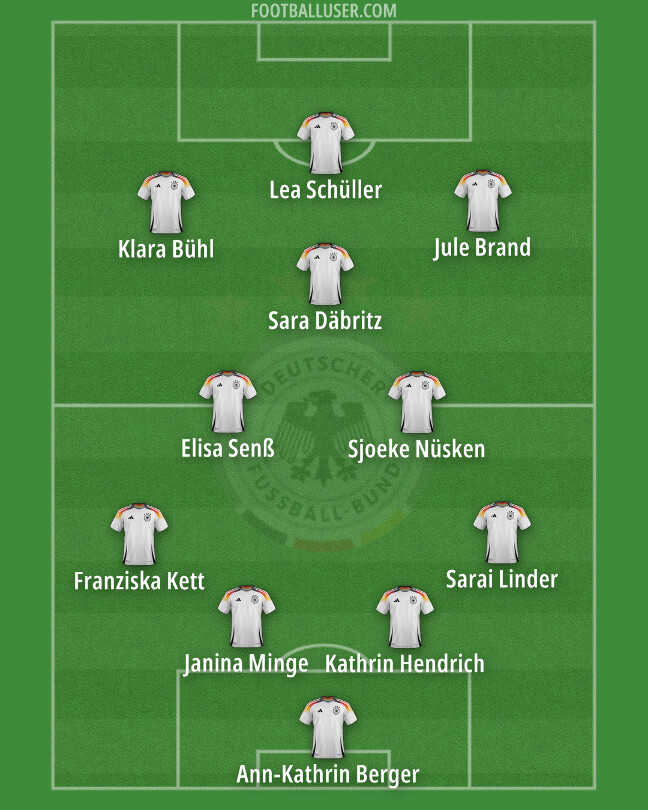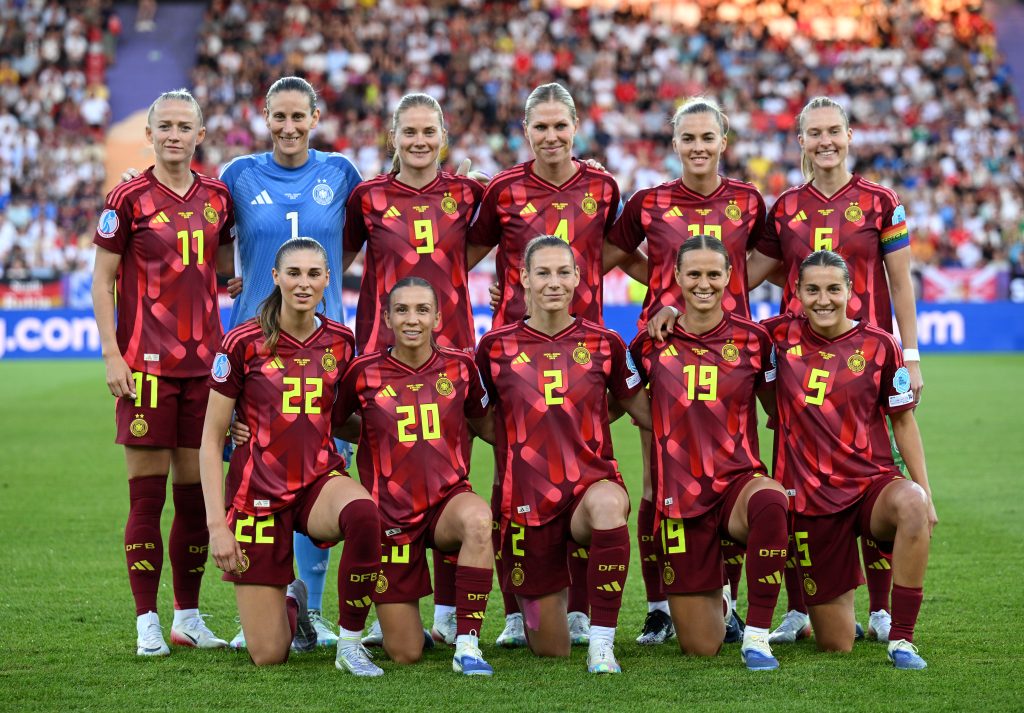3
Ahead of tomorrow’s fourth and last quarterfinal fixture in the 2025 UEFA Women’s European Championship, Get German Football News is pleased to continue its coverage of the German women’s national team with a tactical primer ahead of the match. Bundestrainer Christian Wück’s Frauennationalmannschaft has already received a comprehensive report card for their work in the three group stage games. A total of 18 players received detailed treatment in our previous piece.
Wück faces several personnel and tactical quandaries ahead of tomorrow’s match against France. The German team’s tournament – already upended by an early injury to DFB squad captain Giulia Gwinn – saw matters further disrupted by a red card in the final group stage fixture that will leave Gwinn’s replacement Carlotta Wamser suspended for the quarterfinals. For the first time since Wück assumed his position in October 2024, the Bundestrainer switched out of his 4-2-3-1 formation in the second half against Sweden.
The content that follows is divided up into two sections. The first covers some of the personnel and tactical issues stemming from analysis of the group phase. After that, three potential tactical constellations are presented. Personnel discussions carry on into the second segment. Reasoning eventually leads to selection of the middle option as the best possible bet. The first option mirrors the status quo. The third option counts as a patently German case of over-engineering any given problem.
Four Conclusions from the Group Stage
Conclusion #1: Kathrin Hendrich should start over Rebecca Knaak
As interesting as most of us found it to be introduced to the Manchester City centre back, Wück should turn to veteran leadership in this case. Hendrich’s impending move to the NWSL doesn’t mean that the 33-year-old has lost her touch. Quite the contrary. Hendrich looked as fast and sharp as ever in her 45-minute shift against Sweden. In the women’s game, moves to the States shouldn’t be equated with entry into the MLS “retirement community”.
The report card piece covered the fact that Knaak, for all of her positive attributes, noticeably lacks pace. The 29-year-old compensates for her lack of speed in many admirable ways, but it’s simply not practical to deploy her against a French attacking trident with a demonstrated capacity for running circles around their opponents. Lessons inherent from the Sweden match must not be ignored.
Whatever formation Wück ultimately opts for, Henrich belongs alongside her former VfL Wolfsburg teammate Janina Minge. It should be noted that the two actually haven’t worked together as a centre-half pairing very often. Minge usually features in midfield for her club. They’ve nevertheless sometimes served alongside each other in a back-three. There’s ostensibly some rapport there.
Conclusion #2: Linda Dallmann edges out Laura Freigang
The author went back-and-forth on this one in the report card piece, ultimately hinting that Dallmann should probably start over the Eintracht Frankfurt star. Merely contemplating the notion of moving Freigang back to the bench makes one wish to smack one’s head against one’s desk. Freigang’s club performances continue to leave her the actor on the roster most deserving of a chance of break in with the national team.
It simply never comes together for the 27-year-old. Freigang fluffs her best chances as often as Lena Oberdorf gets injured at the worst possible times. In this particular case, luck simply wasn’t on her side. Wamser’s red card cut her chance at claiming a starting spot short. Keeping her ready on the touchline for a pre-set late relief shift still counts as a requisite. Freigang and Giovanna Hoffmann on together at 70 minutes still works.
Conclusion #3: The attacking axes should remain unaltered
So many underlapped attackers on this team await their chance. The report card piece reserves plenty of space for the likes of Selina Cerci, Giovanna Hoffmann and Cora Zicai. The time for this trio shall definitely come. For the moment, Klara Bühl, Lea Schüller, and Jule Brand all clock in at “A-Level”. Bühl and Brand earn plaudits for the defensive work they’ve turned in during the tournament as well. No changes necessary up top.
Conclusion #4 The midfield axis should remain tight
Sjoeke Nüsken’s tendency to function more as an eight – not to mention the immediate courage she’s demonstrated in her new leadership role – remains commendable. Wück clearly permitted central midfielders to operate on a “split-stagger”. There nonetheless comes a time when such creative license must come to an end. Nüsken and Elisa Senß must remain within ear-shot of each other in what promises to be an intense match.
Three Potential Formations
Option #1: 4-2-3-1
Wück can simply stick to the game-plan here, maintaining the same formation he’s committed to since his tenure began. One paradox of Wück’s presumed procedure concerns the fact that the Bundestrainer often complains about crossing quality when (it appears) he’s ordered his top three axes to cluster together. The team frequently looks disjointed in wider builds and the back-four struggles to spread out on bow-arcs.
Such tendencies – combined with the over-reliance on vertical passing – leads one to the conclusion that it may be time to drop this system. Whether Wück’s ideas are poorly conceived or improperly executed remains irrelevant. Something not working terribly well deserves to be ditched. A personnel problem also crops up here.
Option #1 (4-2-3-1)
Eintracht Frankfurt’s Sofia Kleinherne – though not inexperienced as a right-back – has settled into her role as a central defender over the past two seasons. Kleinherne never received consideration for the right-back role at the 2023 Women’s World Cup despite the team’s urgent need at that position. Kleinherne did start on the left (and score) during the third Euro 2022 group stage fixture against Finland.
Moving Linder to the right and starting either Kleinherne or Franziska Kett (observed below) on the left constitutes an option for Wück. Such tinkering nevertheless risks mistakes. Moreover, the opponent (well aware of the success Sweden had pulverizing the German left) will likely attack Germany’s most vulnerable side first. Linder probably needs to remain in position.
Option #2: 3-2-2-3
A double-eight set up enhances the chances of winning the midfield battles and freeing up the attackers to rotate more spontaneously. Naturally, coverage on the flanks suffers as a result. The back-three didn’t perform terribly in the second half against Sweden, though the Swedes also played down a few gears too. If Wück adequately drilled the five actors at the back during the long training week, such a constellation stands a chance.
Option #2 (3-2-2-3)

Wolfsburg teammates Linder, Minge, and Hendrich know these positions. The author confesses he that he doesn’t know if all three have served together in precisely this capacity for club. Hendrich has worked to the right of Minge in a back-three. Likewise, Linder has worked to Minge’s left. In any event, they made it work for country in the last match. This set-up possesses plenty of promise.
Dallmann and Sydney Lohmann definitely know exactly how to function as double eights for both club and country. Wück surely knows this as well. The Bundestrainer simply held back from deploying them together in the lost-cause fixture. Provided the five actors below contribute their fair share of defensive work, attacking possibilities on the over and underlaps abound.
Option #3: 4-3-3
A third option sees Wück dust off Sara Däbritz to run distribution out of a midfield triangle. Admittedly, this one happens to be somewhat quixotic. Däbritz’s experience leaves her eminently qualified to direct traffic, but how much muscle memory the veteran retains at this point is questionable. Note that this constellation also hands Kett a start despite her recent problems with injury and form for club.
Option #3: 4-3-3

Some subterfuge is at work here. Bühl, Däbritz, and Senß take more responsibility for defending the left than their positions indicate. Kett serves as an invitation for French trainer Laurent Bonadei to send the exceptionally strong right-hand-side of his 4-3-3 running at the perceived weak link. After the likes of Elisa de Almeida, Sakina Karchaoui, and Delphine Cascarino tire out, another tactical switch commences.
Complicated and fun.
Over-engineered in the typical manner in which Germans overthink everything.
Probably wholly impractical.
Doubtful we’ll see something like this.
Recommending Option #2
A clear winner emerges.
As usual, a strategy remains only as solid as the back-up plans. Should the Germans fail to safeguard the flanks, Bühl can always drop back to serve as the left-back in a quick 4-2-3-1 reformat. Freigang and Hoffmann stand at the ready to come on together should any part of the attack merit a re-fresh. Serci and Zicai can come on should the match enter extra-time. Däbritz serves as the last sub if penalties are looming.
At the very least, such a set of tactics should deliver an entertaining and fast-paced match. Diehard fans of the German women’s national team can (having now had some practice in this) accept elimination at the Euros. A meek and uninspired exit remains another matter. One sincerely hopes that the DFB-Mädels ensure that they furnish a match that will keep up interest in the women’s game within the Bundesrepublik and around the world.
GGFN | Peter Weis


